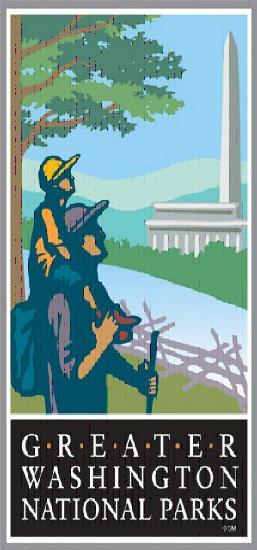Biennial Spotlight on National Park Resources
Agenda from the
Spotlight on National Park Services (NPS)
Resources in the National Capital Region
Slide Show
Spotlight on the NPS Resources
Presentations and Poster Gallery
A Floral Survey of Cliff Habitats Along Bull Run at Manassas National Battlefield Park
Courtney James, Biological Science Technician, National Park Service, Manassas National Battlefield Park; Esther D. Stroh, Matthew A. Struckhoff, and Keith W. Grabner, U.S. Geological Survey, Columbia Environmental Research Center
A Golden Anniversary in a Diamond Year
Kimberly Robinson, Museum Curator, National Park Service, George Washington Memorial Parkway
Accuracy Assessment Results for NCR vegetation maps
Judy Teague, Senior Ecologist, Natureserve; Diane Pavek, Research Coordinator, Botanist NPS, National Capital Region
Ahoy Ye Landlubber! Submerged Cultural Resources along the GWMP
Bradley Krueger, Cultural Resource Specialist, National Park Service, George Washington Memorial Parkway
Assessment of the Environmental Genomics of Aquatic Systems in the National Park Service’s National Capital Region with Emphasis on the Algal Communities Associated with the Nuisance Diatom Didymosphenia geminata
Aaron Aunins - Genetics Biologist, Tim King - Fishery Biologist (Genomics), U.S. Geological Survey, Leetown Science Center
Bats, White-nose Syndrome, and the Western Maryland Railroad Tunnels
Michelle Carter - Natural Resource Program Manager NPS, C&O Canal National Historical Park
Building an Invasive Plant Watch List for the NCR
Mark Frey- Team Liaison, NPS, Exotic Plant Management Team (EPMT)
Bullets, Shrapnel, Case, and Canister: Archeology and GIS at the Piper Farm (Recording Unavailable)
Union and Confederate forces fought at Antietam Creek near Sharpsburg, Maryland, on September 17, 1862. It was the bloodiest single-day battle in American military history with nearly 23,000 dead, wounded, and missing. Some of the fiercest fighting occurred around the Sunken Road -- the northern boundary of the Henry Piper farm. Over four field seasons, archaeologists conducted systematic metal-detector surveys of the Piper Orchard, site of the Confederates’ retreat from the Sunken Road and their stand to hold the center, Caldwell’s Union advance, and the senseless charge of the 7th Maine Infantry Regiment. A combination of GIS analysis, 3-D terrain modeling, viewshed analysis, and a review of the historical record, resulted in the identification of unit positions and movements derived from an examination of 2,033 military artifacts. This study provides a more detailed understanding of the events at Piper Farm and demonstrates potential applications to other battlefield landscapes.
Camera Trap Survey to Assess White-tailed Deer Population at Catoctin Mountain Park, 2015
Lindsey Donaldson - Biologist, Laurel Downs - Student Conservation Assosication NPS, Catoctin Mountain Park
Closing Remarks from the Spotlight on National Park Resources in the National Capital Region
Perry Wheelock- Associate Regional Director, Resource Stewardship and Science, NPS, National Capital Region
Creating a Mobile Experience for the Explore Natural Communities Website
Judy Teague - Senior Ecologist, Allen Ansellmo - Software Engineer, Erin Jones - Vegetation Ecologist, Dave Hauver - Software Engineer Natureserve, Diane Pavek - Research Coordinator, Ann Gallagher - Science Education Coordinator, Urban Ecology Research Learning Alliance, NPS National Capital Region
Determining the Appropriate Unit of Management Among Brook Trout Populations Exhibiting Prodigious Neutral Genetic Differentiation and Cryptic Metapopulations in the Chesapeake Bay Drainages with Emphasis on Catoctin Mountain Park
Tim King- Fishery Biologist (Genomics), U.S. Geological Survey, Leetown Science Center
Gone but not Forgotten: Storer College
Elaine Eff- Former Director, Cultural Conservation Program, Maryland Historical Trust
Integrating Cultural Resource Preservation Priorities at a Landscape Scale: Introduction to the collaborative research program being sponsored jointly by the NPS and Appalachian Landscape Conservation Cooperative
Jean Brennan- Science Coordinator, Appalachian Landscape Conservation Cooperative (LCC)
Interactions Between Climbing Vines and Forest Edges Influence Tree Mortality in Mid-Atlantic Forests
Elizabeth Matthews - Botanist, Megan Nortrup - Science Communicator, John Paul Schmit - Quantitative Ecologist, J Patrick Campbell - Network Coordinator, NPS, National Capital Region Inventory and Monitoring Program
Inventory of Rare Groundwater Invertebrates and Their Habitats in National Capital Parks East Parks
David Culver, Emeritus Professor, American University Department of Biology presented for Jenna Keany, Graduate Student American University Department of Environmental Science
Japanese American Veterans Association Oral History Topic
Amber Cohen - Graduate Student, University of Maryland
Joint Influence of Deer Management and an Invasive Grass on Tree Seedling Establishment at Catoctin Mountain Park
John Paul Schmit- Quantitative Ecologist, NPS, National Capital Region Inventory and Monitoring Program
Mapping Potential Wetland Habitat Throughout the C&O Canal National Historical Park using Remote Sensing and GIS-based Data
Lance Bragin - Graduate Student, Hood College, Environmental Biology Program
Maximizing the use of Volunteers for the Removal of Arborized Invasive English Ivy Vine at Rock Creek Park
Nick Bartolomeo - Chief of Resource Management, Ana Chuquin - Biological Science Technician NPS, Rock Creek Park, John Maleri - Program Coordinator, Karen Zeiter - Program Manager Rock Creek Conservancy























